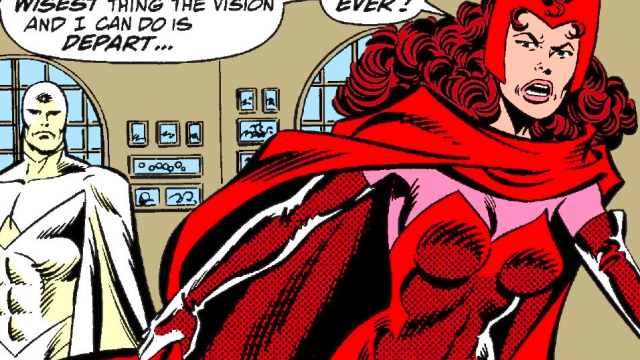With the Scarlet Witch and Vision’s romantic history in Marvel’s comics being the enthralling, convoluted mess that it is, there was a wealth of source material for WandaVision’s creative team to draw from while conceiving the story for Disney+. Because there’s been relatively little of the Scarlet Witch or Vision in the Marvel Cinematic Universe, one of the biggest questions heading into the streaming series was which chunks of the characters’ comics canon it might incorporate, and how the show would go about it.
Everything about the way WandaVision’s premise was advertised — from its jumps through multiple decades of American sitcoms to the not-s0-subtle hints about Wanda Maximoff’s mental state — made it easy to see shades of stories like Brian Michael Bendis’ House of M and Tom King’s The Vision in what was being teased. But the trappings of the MCU (no mutants to speak of yet, SHIELD’s gone, and the Avengers don’t really have the luxury of going out in public) necessitated WandaVision being a unique story capable of straddling the comics and live-action adaptations.
After three highly-styled conceptual episodes meant to pull you into its mysteries, WandaVision’s fourth episode, “We Interrupt This Program” introduced truckloads of new information. Most importantly, it began answering questions like, how does Monica Rambeau fit into all of this? But in addition to presenting its first big picture exploration of the Westview anomaly, WandaVision’s most recent episode also highlights just how closely the show’s plot is paralleling a specific set of West Coast Avengers comics from the mid-‘80s.
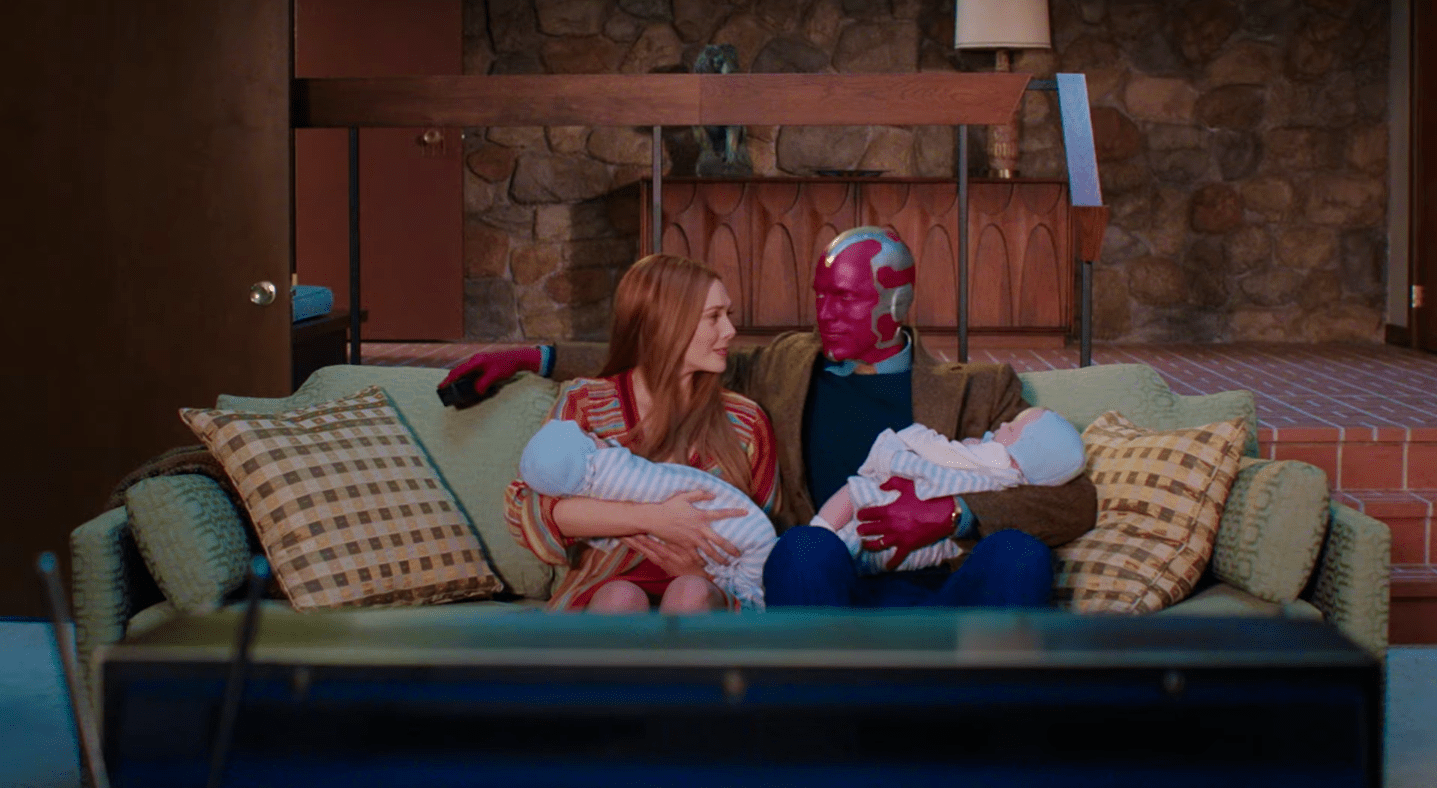
After welcoming Wanda and Vision’s twin sons Billy and Tommy (more on them in a bit) into the world, WandaVision got down to the important business of filling us all in on what happened in the MCU outside of Westview in the time between Avengers: Endgame and WandaVision, by way of Monica (Teyonah Parris). After Monica becomes involved in SWORD’s investigation into Westview, and she’s suddenly sucked into the bubble, agent Jimmy Woo’s (Randall Park) left to mobilise with Darcy Lewis (Kat Dennings), a team of other scientists, and a whole fleet of SWORD operatives focused on discovering the bubble’s mysteries.
Though “We Interrupt This Program” features a handful of significant scenes within Westview, it’s what Darcy’s able to learn about the city from the outside that ends up being intriguing by the episode’s end because of how her observations gesture towards the comics. By analysing the energy flowing out of Westview, Darcy picks up on a growing amount of cosmic microwave background radiation as well as a strange signal that just so happens to be readable by old fashioned tube TV sets.
[referenced id=”1668339″ url=”https://gizmodo.com.au/2021/01/wandavisions-menacing-signal-is-finally-cutting-through-the-noise/” thumb=”https://gizmodo.com.au/wp-content/uploads/2021/01/30/xv8xkldqmte0vhfzizaj-e1612127415427-300×156.png” title=”WandaVision’s Menacing Signal Is Finally Cutting Through the Noise” excerpt=”After WandaVision’s first three episodes, the series was in the position to make a choice whether to keep on focusing specifically on Wanda and Vision’s suburban bubble reality, or finally shift focus to one of its other characters like Monica Rambeau, whose perspectives might provide some important information about the…”]
With a direct channel to the in-universe WandaVision, Darcy, Jimmy, and the rest of SWORD are able to begin piecing together profiles of the “show’s” “characters,” all of whom are real people with New Jersey drivers licenses who seemingly vanished into the MCU’s fictionalised Westview before showing up on the TV broadcast. Though it was difficult to see what was written on the residents’ profiles, what was noticeable about how they were presented was who and what was missing; unlike everyone else on the board, Wanda’s neighbour Agnes was without an ID, and the neighbourhood housewife bully, Dottie, was missing from the board altogether.
Conspicuous as Dottie’s absence was, it was easily explained away by the fact that, so far, WandaVision’s in-universe show characters like “Geraldine” were only able to show up once their “real” counterparts entered the town. Agnes, though, is more difficult and curious to explain because she may have been there since the very beginning — WandaVision’s trailers have heavily suggested that she’s the MCU’s answer to Agatha Harkness, Wanda’s powerful witch mentor in the comics. Though the latest episode doesn’t explicitly say much about Agnes’ identity, it does take a brief moment to explain that, best as SWORD can tell, the “bubble” around Westview actually forms a kind of hexagon, a shape that may hold significance beyond including the word “hex.”

When Wanda and Vision abscond to Leonia, New Jersey in Steve Englehart and Richard Howell’s The Vision and the Scarlet Witch, the locals are aghast when the pair buy a home, settle, and end up having a rather inexplicable pair of twin boys, a seeming impossibility considering Vision’s always been an inorganic synthezoid with no genetic material to pass on. Strange as the couple’s whole deal is, it isn’t really until John Byrne and Bob Sharen’s run on West Coast Avengers some years later that the entire situation began to unravel and be dissected by those party to it.
Sometime after the Vision’s first “death,” during the “Vision Quest” arc, he was rebuilt by Hank Pym in a process that left his body drained of colour, and with most of his original “human” personality missing — because Wonder Man refused to let his brain patterns (which were part of Vision’s original build) be rescanned. Distressing as Vision’s new form is to Wanda, she’s able to cope with his strangeness up to a point because his return means that their family is intact once again, and because she and the other West Coast Avengers constantly have their hands full with a string of attacks from Master Pandemonium, an actor-turned-literal-demon looking for missing pieces of his soul.
As the Scarlet Witch attempts to return to her normal life as an Avenger, though, she begins to receive a number of strange reports from Billy and Tommy’s nurses that are some of the first indications that something’s wrong with the twins. Unlike a lot of other super babies in comics, Billy and Tommy were both relatively unremarkable throughout most of their infancies, save for the repeated instances while their parents were away when the boys would suddenly vanish whenever their babysitters weren’t watching them. At this point in Marvel’s comics, Byrne gave Wanda a decidedly more assertive and active voice on the Avengers…which most commonly manifested as her flying off the handle at her kids’ beleaguered sitters. While the Avengers keep themselves busy with their regular superhero work, Wanda hires and then fires nanny after nanny for losing sight of her children, never stopping to considering the possibility that Billy and Tommy might be magical mutants like her.
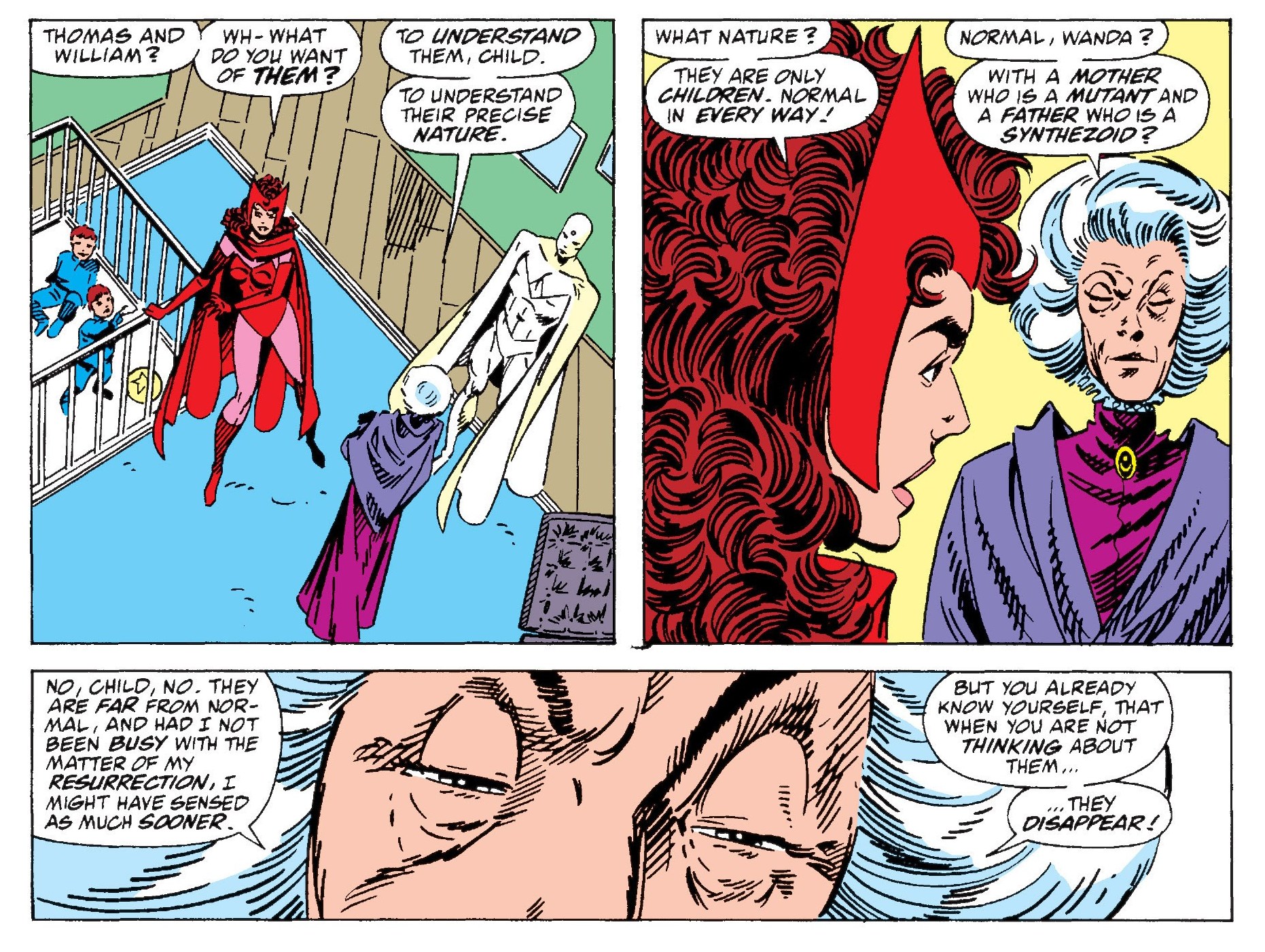
But when Agatha Harkness returns from the dead months after being burned at the stake just in time to help drive a horde of monsters away from the Scarlet Witch and Vision’s home, she immediately corners the parents and confronts them about what she’s observed about their children’s disappearing act. Even though WandaVision’s yet to make mention of any demons or witchcraft, the rhyming pattern between the show and Marvel’s comics only gets stronger the deeper into the arc you read. Sensible as Agatha’s read on Wanda’s children in the comics was, it isn’t until the villainous Master Pandemonium returns to their home with more demons and kidnaps Billy and Tommy that Wanda begins to listen to Agatha’s theory about what’s happening.
In Marvel’s comics, Master Pandemonium comes into his mystical powers after he suffers an almost fatal car crash in his human persona, Martin Preston, losing an arm in the process. When the demon Mephisto offers to save Preston’s life and gift him with a pair of demonic arms, Preston accepts — while not understanding that in exchange, Mephisto rips out his soul, leaving a star-shaped hole in his abdomen meant to represent the price he’s paid. Though stars haven’t been featured all that much in WandaVision, the show’s repeated use of hexagons feels, in a way, like it could be the show’s answer to how shapes factor into the Scarlet Witch’s lore. A soulless actor rising out of the pits of hell to harass the Scarlet Witch and her family fits well within the general scope of the sorts of ideas the Disney+ series has been playing around with. So, unsurprisingly, you can see echoes of The West Coast Avengers all throughout the episodes of WandaVision that have aired so far.
[referenced id=”1666705″ url=”https://gizmodo.com.au/2021/01/wandavision-is-serving-up-mayhemfor-the-children/” thumb=”https://gizmodo.com.au/wp-content/uploads/2021/01/22/fvu8urodqdu9io7ldor8-e1611525223587-300×153.png” title=”WandaVision Is Serving Up Mayhem… For the Children” excerpt=”While WandaVision’s double feature of a premiere dropped us right into the swing of a warped, in-universe television reality with no real explanation or context to make it easier to grasp what the hell is going on, the series’ sudden jump into a new era started to paint a more…”]
When the rest of the Avengers set to pressing Harkness for more information, her story of returning from the dead is difficult for them all to process save for Wonder Man, who recalls a similar series of events being part of an episode of the real-world TV show Bewitched.
Everything that Agatha tells the Avengers is true, and then some, but what none of the heroes know is that outside their dimension, the villain known as Immortus watches everything that’s unfolding. Immortus’ appearance here is brief, but he makes clear that he’s pleased with what’s happening on Earth, as it’s part of his longer con that comes to the fore much later. The important thing to keep in mind about Immortus is that, in the comics, he is a distant future version of Kang the Conqueror, a time-travelling villain set to make his MCU debut in Ant-Man & The Wasp: Quantumania. Both Kang and Immortus are also descendants of the Fantastic Four’s Reed Richards because comics insist on being excessively wild, and it’s worth noting that the Fantastic Four are also making their way to the big screen once again as part of Marvel’s films.
Comic scenes, like when Agatha wrenches open a portal between the realms to find Billy and Tommy, feel like the basis for how WandaVisions’ “We Interrupt This Program” shows us Monica and the Beekeeper’s transitions into Westview, right down to the fact that the place the Avengers are transported into in the comics is a frightening wonderland of things that don’t seem real. What proceeds to play out in the pages of The West Coast Avengers is a prime example of how the twisty, soap opera quality of comic book stories has a tendency to leave the canon a bit messy when you try to process the whole of it.

True to Agatha’s word, the Avengers stumble upon Pandemonium along with Billy and Tommy, and they discover that the demon’s absorbed the babies into his body in order to intensify his strength. More than that, though, Pandemonium explains to Wanda that the reason he’s able to bond with her sons is that their souls are, in fact, two shards of his shattered soul that he’s been searching for.
WandaVision’s never tried to hide its interest in exploring Wanda and Vision’s children, but the big question still looming is how the series intends to do so. A straightforward jump to seeing the boys as teens would provide a route for the MCU to fast track an incarnation of the Young Avengers — joining the likes of incoming stars like Hawkeye’s Kate Bishop and Multiverse of Madness’s America Chavez. But for the sake of WandaVision’s story, it seems unlikely that the show would just jump over the drama of the boys’ childhoods, as well as its implications for their parents and the rest of the Avengers.
Part of the Avengers’ victory over Pandemonium in the comics comes after Hank points out in the middle of the battle that Billy and Tommy were born after Pandemonium’s initial deal with Mephisto, meaning it was impossible that the twins’ souls were the villain’s. This, it turns out, is true, as Mephisto has a fondness for lying as well as manipulating others when it comes to getting what he wants. Through all of this, Wanda hopes that the twists and turns of fate are all leading back to her being reunited with her children, but happiness isn’t in the cards for her, here.
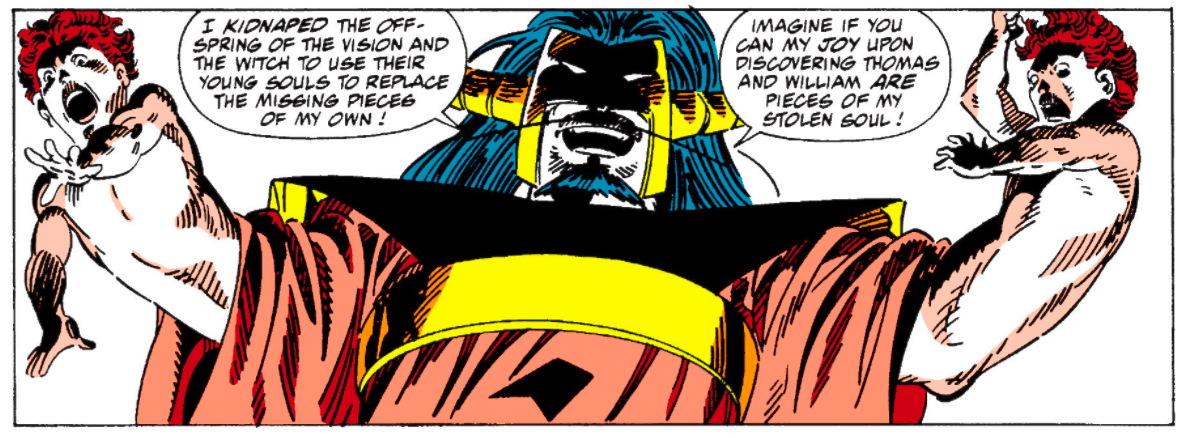
Instead, Mephisto explains that everyone’s been working with partial truths. Though Billy and Tommy were formed using shards of a shattered, demonic soul, they were made from pieces of Mephisto’s soul, ones that were left in the wake of a battle with the Fantastic Four’s Franklin Richards that destroyed the demon. Using her control of chaos magic, Wanda subconsciously reached out and took hold of two of Mephisto’s soul shards, which he would have simply come back for himself were it not for his brokenness drastically reducing his own power.
The combined powers of Agatha and the Avengers are enough to ultimately destroy Mephisto once again but at the cost of destroying Billy and Tommy as well. Agatha hides this painful reality from Wanda by erasing any memory of the boys from her mind, and this particular chapter of The West Coast Avengers kicks off Marvel’s decades-long comics tradition of putting the Scarlet Witch through absolute hell.
WandaVision’s preoccupation with children from the very first episode was one of the obvious clues about where the series was heading thematically down the line. In addition to ideas about suburban domesticity, the show’s take on Billy and Tommy sets up the potential for a Pandemonium-focused small picture story, about a demon snatching up fake baby souls in New Jersey, and multiple shifts in the larger MCU depending on how closely the series and movies track to the comics.
In thinking “Why Jersey?” about WandaVision’s setting, it’s important to recall that it’s just where the two happened to settle, canonically, but it’s interesting to consider whether Pandemonium and Mephisto, who’s sometimes known as the devil, might be lurking in the Garden State. WandaVision poking fun at Mephisto by likening him to the Jersey Devil — a classic figure in the state’s lore — would gel with the show’s overall sense of humour, but explicitly bringing the character into play here would also work as a sensible precursor to Doctor Strange in the Multiverse of Madness, the next Marvel film where the Scarlet Witch is set to show up.
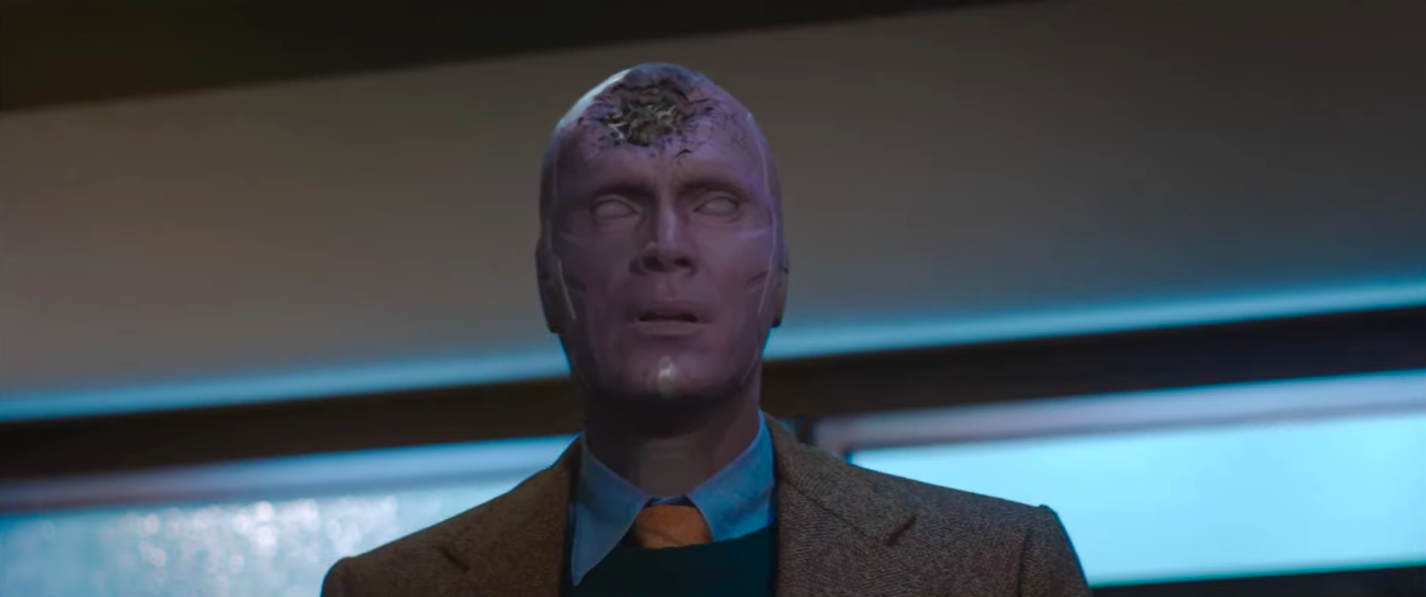
WandaVision’s meant to establish how and why Wanda comes to be known by her comic superhero monicker, but if the series ends up really leaning into the West Coast Avengers, there’s also a chance that characters like Kang the Conqueror and the Fantastic Four (who all have myriad, distant connections to this arc in the comics) could be implicitly alluded to in a very roundabout way. Another part of this West Coast Avengers arc’s storyline follows the Avengers as they look deeper into the Vision’s origins, which they’d previously believed to be tied up in the creation of the original android known as the Human Torch. But aside from the connections to Vision, during their investigation, Scarlet Witch fascinatingly and rather casually brings the android Torch back to life in order to help substantiate her belief about who Vision is — not unlike how, say, WandaVision has clued us in that the “Vision” we’ve seen in the show appears to be quite dead.
To be clear, essentially all of the comic story’s Fantastic Four pieces are missing in the MCU. However, we know the superheroes team is on the way so it’s worth considering whether they’re being teased in small ways like WandaVision purposefully naming the SWORD agent who’s sent into Westview “Franklin,” if only as Easter Eggs. It seems unlikely that Immortus’ brief appearance in this section of The West Coast Avengers will end up being reflected in Kang the Conqueror’s presence in Quantumania, but now that the studios are getting more comfortable with multiverses, it doesn’t seem wholly out of the realm of possibility.
All of this still leaves standing questions for WandaVision, like who Agnes actually is and what the hexagon’s shape means, but those things are likely going to be directly answered as we get close to the season’s finale. It’s anyone’s guess what WandaVision’s truth is, but with a hexagon drawn around Westview and at least two babies having just been “born” into the city, it’s going to be very interesting to see whether spells and soul magic turn out to play a pivotal role here.
WandaVision is now streaming on Disney+.
